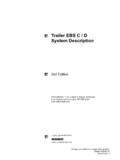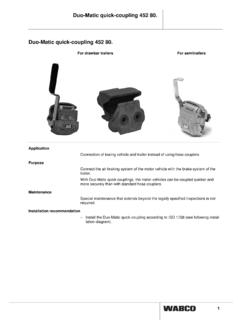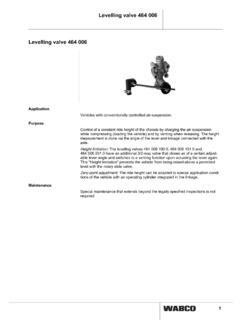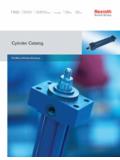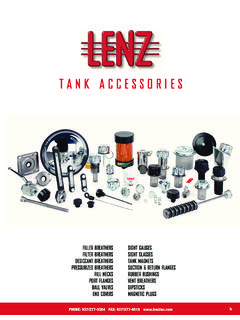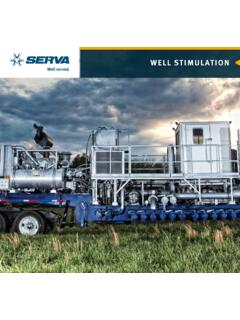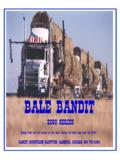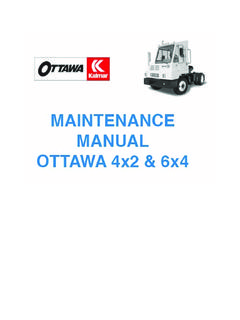Transcription of Hydraulic ADD-ON ABS system - inform.wabco-auto.com
1 Hydraulic ADD-ONABS systemSystem description81500043031st edition Copyright WABCO 2003 Vehicle Control SystemsAn American Standard CompanyThe right of amendment is reservedVersion 002 brake functions and tasks of the anti -lock brake anti -lock brake system control the driver needs to of modified individual control (MIC)? the anti -lock brake system of electronic brake force distribution (EBD) of electronic traction control (ETC) brake system warning traction control of operation without electronic traction of operation during electronic traction buildup / pressure holding / with electronic traction diagram / offer system fault brake a new a new speed a new of the of vehicles according to EC Directive 98/12 principles of sequence of the braking with the ADD-ON anti -lock brake to bear in wheel specification46 Table of contentsHABS4 Introduction / General IntroductionThis publication dealing with the WA-BCO Hydraulic ADD-ON anti -lockbrake system 4S/4M 12 V (HABS),WABCO system part number 400050.
2 0, is intended for workshopengineers, drivers and companies in-stalling the system in their addition to operating information, itcontains additional technical detailsand safety instructions. Furthermore,this publication is intended to helpthe workshop engineer to maintain,repair and diagnose faults in the this publication, WABCO is also of-fering some information for compa-nies who install the system in theirvehicle, in order to assist them interms of vehicle design. More information about the systemcan be obtained from our ServiceHotline, telephone number 0180 2232337, or on the Internet at General operating and safety Hydraulic brake systemBrakes are a primary safety compo-nent, incorrect work on brakes mayresult in them failing to operate.
3 Onlytrained personnel are allowed to per-form any maintenance and repairwork on the brake system . Take careto maintain absolute cleanlinesswhen working on the brake the negative battery ter-minal before starting any work on theelectrical driver of the vehicle is responsi-ble for performing the following work: Checking the brake fluid level Checking the effectiveness of thebrake systemChecking the fluid levelThe fluid level must always be be-tween the MAX and MIN slight reduction in the fluid leveltakes place in the course of normaldriving and is caused by the auto-matic adjustment of the brake pads(wear).However, there may be a leak in thebrake system if the fluid level dropssignificantly within a short period the brake fluidBrake fluid is hygroscopic, whichmeans it absorbs water.
4 Excessivewater content in the brake fluid mark-edly reduces its boiling point. Thiscan result in brake failure if the wheelbrakes are very hot. As a result, the brake fluid must bechanged in accordance with the vehi-cle manufacturer's fluid is poisonous!Consequently, always keep itsealed in its original container andin particular store it out of thereach of , bear in mind that brakefluid also attacks the vehicle's to the disposal problem, theneed for special tools and the techni-cal expertise required, you shouldonly have your brake fluid changedby authorised specialist eye protection when changingthe brake fluid.
5 If brake fluid comesinto contact with any parts of yourbody during or after the necessarywork, immediately wash it off withsoap and immediate medical attention ifany is swallowed or you get any inyour !53. system descriptionThis chapter describes the basicfunctions of the anti -lock brake sys-tem and its tasks, as well as the gen-eral structure of the system with itsmechanical and electrical AbbreviationsTo aid understanding, it is necessaryto present a few basic definitions be-fore explaining the functions of systemAn ADD-ON system can be installedinto an existing, conventional dual-circuit service brake systemHABSH ydraulic anti -lock brake systemABSAnti-lock brake systemECUE lectronic control unitEBDE lectronic brake force distributionETCE lectronic traction control (traction help)
6 BWLB rake warning lightFour-channel modulatorThe brake pressure on each individ-ual wheel is controlled by one outletand one inlet valve each, thereare four outlet and four inlet valves inthe shaftThis is the axle which carries thetorque from the engine to yourwheels. It may also be a steering ax-le, depending on the type of individual control(ABS control algorithm)4S/4M4 wheels fitted with sensors and 4wheels with brake pressure electrical system voltage V = 12 system structureThe vehicle's brake system consistsof a Hydraulic brake master cylinderwith a brake booster as the actuationdevice and four Hydraulic wheelbrakes on the front and rear WABCO ADD-ON ABS systemconsists of:1.
7 A four-channel brake pressuremodulator. The brake pressure ateach wheel is controlled by anoutlet and an inlet valve. If thebrake pressure drops during ABSbraking, a return pump pumps thebrake fluid back into the brakemaster cylinder (closed system ),2. four speed sensors with impulsewheels which constantly monitorthe speed of each wheel,3. and a central electronic controlunit (ECU).The ECU processes the four speedsignals from the wheels and causesthe solenoid valves to be appropriate solenoid valves arepulsed according to the require-ments, in order to maintain, reduceor increase the brake , the ECU monitors itsown functions and checks the electri-cal components of the system .
8 TheECU automatically switches over tosafe mode if a component fails. Insuch cases, the normal function ofthe service brake is ISO 9141 diagnostic interfaceforms part of the ECU. This permitsmessages stored during operation tobe downloaded from the ECU'smemory Basic functions and tasks of the anti -lock brake systemThe principal task of the ABS systemis to guarantee that the vehicle canstill be steered and holds its courseduring brake systems (ABS) - gen-erally also referred to as anti -locksystems (ALS) - must prevent the ve-hicle's wheels from locking as a re-sult of excessively powerfulactuation of the service brake , mainlyon slippery road the critical locking point of thewheels is reached during braking,the brake pads are pulsed (releasedand reapplied)
9 Within fractions of asecond. This permits the wheels tocontinue to turn and means that thevehicle can still be steered, even dur-ing full braking. Despite the advanced developmentstatus of commercial vehicle brakes,potential accident situations oftenoccur when braking on slippery roadsurfaces. During full or even partialbraking on a slippery road, it may nolonger be possible to transmit all ofthe brake force onto the road due tothe low coefficients of friction be-tween the tyres and the braking force is excessive andthe wheels lock up. When the wheels are locked up, theycease to offer any purchase on theroad and they transmit almost no cor-nering forces (steering and trackingSystem ).
10 This often has dangerousconsequences. The vehicle cannot be steered The vehicle swerves despitecountersteering and starts to skid The braking distance issignificantly a result, cornering forces onbraked wheels should be maintainedeven during full braking, so as toguarantee that the vehicle or vehiclecombination remains stable and canstill be steered as far as physicallypossible. At the same time, the fric-tion contact between tyres and thecarriageway should be fully opti-mised, therefore reducing the brak-ing distance and making the vehicledecelerate more rapidly. Requirements on ABS: ABS must work even at very slowspeed.
